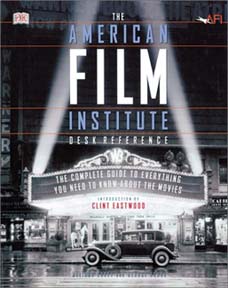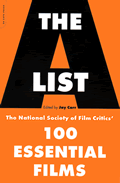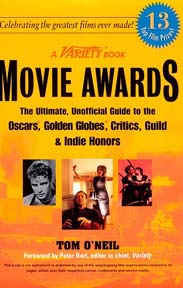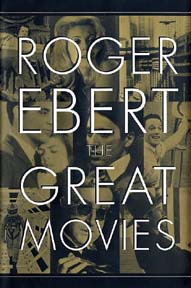If there's one thing I enjoy more than watching movies,
it's reading about them. So, it's not surprising that a simple collection
development project I recently finished for Kitsap
Regional Library took me days of research rather than hours. In
building a collection of classic films on DVD, I got a little sidetracked
with books....
 My
first diversion was The American Film Institute Desk Reference
by Melinda Corey, et al (Dorling Kindersley; 2002), chosen mainly
for its visuals - think Eyewitness for adults. There is more
to the book than photographs, though. Along with its detailed timeline
of films and film technology, there are glimpses of behind-the-scenes
movie crafts: writing, cinematography, editing, costumes, distribution,
etc.
My
first diversion was The American Film Institute Desk Reference
by Melinda Corey, et al (Dorling Kindersley; 2002), chosen mainly
for its visuals - think Eyewitness for adults. There is more
to the book than photographs, though. Along with its detailed timeline
of films and film technology, there are glimpses of behind-the-scenes
movie crafts: writing, cinematography, editing, costumes, distribution,
etc.
A source chapter gives addresses, phone numbers,
and websites for contacting studios, players, agents, film schools,
and film libraries around the world. My favorite chapter was "Movie
Quotations." Some gems: "There's a name for you ladies,
but it isn't used in high society - outside of a kennel." (Joan
Crawford; The Women; 1939) "Is this the big secret that
you've been keeping from me? Is it that you're a mermaid, or is there
something else?" (Tom Hanks; Splash; 1984) "That's
silly, honey. People just don't get smaller." (Randy Stuart;
The Incredible Shrinking Man; 1957) If you know of anyone interested
in pursuing a film or film librarian career, this would be the perfect
holiday gift.
 The
next book I spent time with was The A List: The National Society
of Film Critics' 100 Essential Films, edited by Jay Carr (De Capo
Press; 2002). It wasn't relaxing time, though; it was combative, sometimes
humbling, and always engaging. Knowledge of these films is meant to
represent "film literacy," according to Carr, and he admits
that several members of the Society walked out in protest at the final
choices.
The
next book I spent time with was The A List: The National Society
of Film Critics' 100 Essential Films, edited by Jay Carr (De Capo
Press; 2002). It wasn't relaxing time, though; it was combative, sometimes
humbling, and always engaging. Knowledge of these films is meant to
represent "film literacy," according to Carr, and he admits
that several members of the Society walked out in protest at the final
choices.
Many of the hundred picks are understandable: Blow-up;
Chinatown; Nashville; The Searchers. But Dance, Girl, Dance? Killer
of Sheep? Just when I was feeling like a film neophyte, I saw
one of my guilty pleasures on the list: Elvis's Jailhouse Rock!
That's the appeal of this book - it's unpredictable and provocative,
and the intelligent arguments for each film will challenge you to
create your own list of necessary movies.
 Since
the grant money I was spending for my project was earmarked for "Award-winning"
films, Variety's Movie Awards: The Ultimate, Unofficial Guide to
the Oscars, Golden Globes, Critics, Guild and Indie Honors, edited
by Tom O'Neil (Perigee Books; 2001), seemed a practical choice for
getting down to work - not! Yes, it has the awards facts, but is also
has the "real stories" behind the awards: The politics (and
corruption), the catty remarks of the losers, the drunken parties
afterwards - in short, the best collection of Hollywood gossip I've
seen collected in one volume.
Since
the grant money I was spending for my project was earmarked for "Award-winning"
films, Variety's Movie Awards: The Ultimate, Unofficial Guide to
the Oscars, Golden Globes, Critics, Guild and Indie Honors, edited
by Tom O'Neil (Perigee Books; 2001), seemed a practical choice for
getting down to work - not! Yes, it has the awards facts, but is also
has the "real stories" behind the awards: The politics (and
corruption), the catty remarks of the losers, the drunken parties
afterwards - in short, the best collection of Hollywood gossip I've
seen collected in one volume.
At the same time, it's a fascinating history of movies
and movie criticism. O'Neil takes each year, beginning in 1928, and
tracks the movies vying for awards, and describes how each group of
critics arrived at its choices. (The critics, by the way, are as badly
behaved as the stars and studio heads. The New York Film Critics Circle
finally had to ban alcohol at its nomination sessions after too many
brawls.) Gee, if only this book had a quick reference section, where
all the awards were listed together chronologically, I wouldn't have
had to spend a whole day on the couch with it.
 I've
disagreed with Roger Ebert on many movies over the years (I was always
more of a Siskel fan), so I didn't expect to get lost in his The
Great Movies (Broadway Books; 2002). But I ended up reading the
book cover-to-cover! Ebert's love and knowledge of films radiate this
"landmark tour" through the first century of film - and
the man can certainly craft an essay. Based on these writings alone,
I've rented many a film, and now some of Ebert's most-admired films
are also my own.
I've
disagreed with Roger Ebert on many movies over the years (I was always
more of a Siskel fan), so I didn't expect to get lost in his The
Great Movies (Broadway Books; 2002). But I ended up reading the
book cover-to-cover! Ebert's love and knowledge of films radiate this
"landmark tour" through the first century of film - and
the man can certainly craft an essay. Based on these writings alone,
I've rented many a film, and now some of Ebert's most-admired films
are also my own.
Here's what drew me to The Passion of Joan of
Arc: "You cannot know the history of silent film unless you
know the face of Renee Maria Falconetti." And I had to see Detour,
a film made in six days, after reading: "Detour is a movie so
filled with imperfections that it would not earn the director a passing
grade in film school...And yet it lives on, haunting and creepy, an
embodiment of the guilty soul of film noir."
After reading Ebert's exquisite piece on McCabe
& Mrs. Miller, I saw the film with entirely new eyes, and
recognized it as the "poetry" he describes. To add to the
delight of this book, each essay is accompanied by a white-and-black
still that perfectly epitomizes the film.
Truthfully, I needn't have used any books for my
project. I could have found all the Awards lists on the Internet in
a matter of minutes. (And, to give credit where credit's due, I did
use Amazon's Internet Movie
Database for checking to see which titles were on DVD.) But would
I have been tempted to waste as much time? Not likely, and that's
what made my project fun!


 My
first diversion was The American Film Institute Desk Reference
by Melinda Corey, et al (Dorling Kindersley; 2002), chosen mainly
for its visuals - think Eyewitness for adults. There is more
to the book than photographs, though. Along with its detailed timeline
of films and film technology, there are glimpses of behind-the-scenes
movie crafts: writing, cinematography, editing, costumes, distribution,
etc.
My
first diversion was The American Film Institute Desk Reference
by Melinda Corey, et al (Dorling Kindersley; 2002), chosen mainly
for its visuals - think Eyewitness for adults. There is more
to the book than photographs, though. Along with its detailed timeline
of films and film technology, there are glimpses of behind-the-scenes
movie crafts: writing, cinematography, editing, costumes, distribution,
etc.  The
next book I spent time with was The A List: The National Society
of Film Critics' 100 Essential Films, edited by Jay Carr (De Capo
Press; 2002). It wasn't relaxing time, though; it was combative, sometimes
humbling, and always engaging. Knowledge of these films is meant to
represent "film literacy," according to Carr, and he admits
that several members of the Society walked out in protest at the final
choices.
The
next book I spent time with was The A List: The National Society
of Film Critics' 100 Essential Films, edited by Jay Carr (De Capo
Press; 2002). It wasn't relaxing time, though; it was combative, sometimes
humbling, and always engaging. Knowledge of these films is meant to
represent "film literacy," according to Carr, and he admits
that several members of the Society walked out in protest at the final
choices.  Since
the grant money I was spending for my project was earmarked for "Award-winning"
films, Variety's Movie Awards: The Ultimate, Unofficial Guide to
the Oscars, Golden Globes, Critics, Guild and Indie Honors, edited
by Tom O'Neil (Perigee Books; 2001), seemed a practical choice for
getting down to work - not! Yes, it has the awards facts, but is also
has the "real stories" behind the awards: The politics (and
corruption), the catty remarks of the losers, the drunken parties
afterwards - in short, the best collection of Hollywood gossip I've
seen collected in one volume.
Since
the grant money I was spending for my project was earmarked for "Award-winning"
films, Variety's Movie Awards: The Ultimate, Unofficial Guide to
the Oscars, Golden Globes, Critics, Guild and Indie Honors, edited
by Tom O'Neil (Perigee Books; 2001), seemed a practical choice for
getting down to work - not! Yes, it has the awards facts, but is also
has the "real stories" behind the awards: The politics (and
corruption), the catty remarks of the losers, the drunken parties
afterwards - in short, the best collection of Hollywood gossip I've
seen collected in one volume.  I've
disagreed with Roger Ebert on many movies over the years (I was always
more of a Siskel fan), so I didn't expect to get lost in his The
Great Movies (Broadway Books; 2002). But I ended up reading the
book cover-to-cover! Ebert's love and knowledge of films radiate this
"landmark tour" through the first century of film - and
the man can certainly craft an essay. Based on these writings alone,
I've rented many a film, and now some of Ebert's most-admired films
are also my own.
I've
disagreed with Roger Ebert on many movies over the years (I was always
more of a Siskel fan), so I didn't expect to get lost in his The
Great Movies (Broadway Books; 2002). But I ended up reading the
book cover-to-cover! Ebert's love and knowledge of films radiate this
"landmark tour" through the first century of film - and
the man can certainly craft an essay. Based on these writings alone,
I've rented many a film, and now some of Ebert's most-admired films
are also my own.